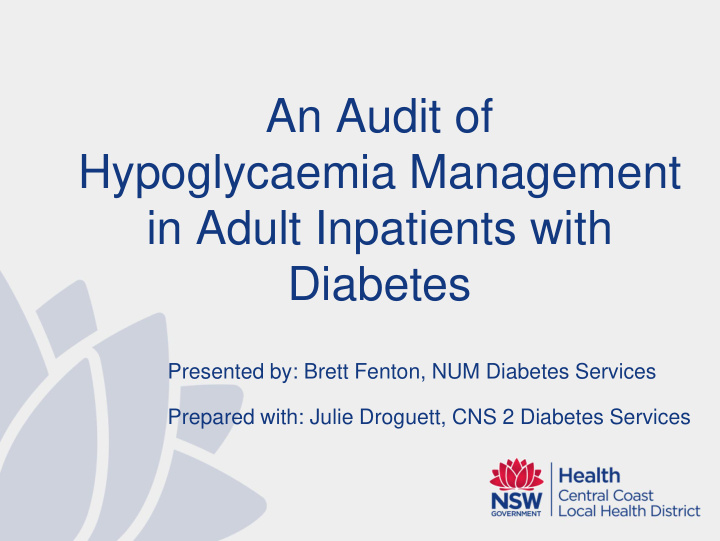



An Audit of Hypoglycaemia Management in Adult Inpatients with Diabetes Presented by: Brett Fenton, NUM Diabetes Services Prepared with: Julie Droguett, CNS 2 Diabetes Services
Background and Rationale Gosford and Wyong Hospital combined have approximately 800 beds Hypoglycaemia is defined BGL <4.0 mmol/L For each day with hypoglycaemia, patients’ length of stay (LOS) is increased by 2.5 days¹ Approximately 23% of inpatients with diabetes experience hypoglycaemia at least once during their stay²
Aim and Objective Several hypoglycaemia incidents prompted the need to investigate: a) Frequency of hypoglycaemia events in the acute care setting b) Does management match current evidence based guidelines .
Methodology Demographic: age, gender, diabetes type and duration Reason of admission and co-morbidities Medication (insulin and/or sulfonylureas) Number and severity of hypoglycaemia episodes Documentation on bed chart and progress notes Follow-up and ongoing management e.g. medication reviewed and adjusted? Was blood glucose level re-tested 15 minutes later? Treatment administered?
Table 1: Demographic data Patients Insulin/ Total patients Patients Patients Sulfonylureas with Diabetes with Hypos 489 89 52 29 (56%) Total M=230; M=42; F=46; F=255; M=27; F=25 M=16; F=13 Gender (Missing=1) Missing=4 71.5 +/- 14.9 70.5 +/- 15.2 72.7 +/- 14.7 Age (years) 69.9 (Range: 18 – 93) (Range: 22 – 93) (Range: 37 – 90) Av LOS 26.2 +/- 17.5 21.2 +/- 18.4 22.3 +/- 18.0 n/a (Range: 2 – 94) (Range: 2 – 63) (days) ( Range: 5 – 63) Diabetes 21.8 +/- 14.1 25.9 +/- 13.7 19.0 +/- 14.2 n/a Duration (Range: 3 – 49) (Range: 0.5 – 49) ( Range: 5 – 49) (years) (Missing=68) (Missing=35) (Missing n= 17)
Results 205 hypoglycaemic episodes were documented among 29 patients. 14 episodes were from sulfonylureas alone 15 episodes were severe with a BGL <2.0 mmol/L Only 18/205 (9%) episodes were rechecked within 15 mins, (range 5 mins - >24hrs, avg 116 mins) 2/3 of documented treatment was incorrect
Results 69 (34%) episodes had no documented treatment Hypoglycaemia managed poorly for people with Insulin infusions Diabetes history poorly documented, 20% did not state diabetes type and 76% did not state duration 10% of all IIMS in our LHD for medications are related to insulin
Case Study: AH, T2 Diabetes Admitted with cellulitis, previous cardiac history, 2 medical wards during admission of 39 days Insulin was withheld on 10 occasions, 12 missed doses, 27 stat doses 33 hypoglycaemic episodes recorded, 12 did not receive any documented treatment, only 8/33 were retested within 15 minutes, 5 recorded under 2.0 mmol/L Insulin Infusion – tx not as procedure
Recommendations and Actions Review and promote Diabetes procedures Mandatory diabetes education for all Nurses Nurse Managers to promote documentation/treatment of hypos, & ensure Hypo kit on ward is checked daily Diabetes Educator for Gosford & Wyong Hospitals Diabetes Inpatient Working Party Clinical Directors Recommend: Medical assessment on admission and identify type of diabetes and risk of hypoglycaemia
HYPO KIT Not if patient is unconscious or unable to swallow.
Conclusion The audit reveals that, in the majority of cases, procedures for hypoglycaemia management were not being followed. Staff knowledge regarding Hypoglycaemia management was poor There is an increased awareness of Diabetes and a better understanding of the importance of Diabetes Educators Plan to re-audit in 2016 – to evaluate the success of implementing recommendations
References 1 . Turchin A, Matheny ME, Shubina M, Scanlon JV, Greenwood B, Pendergrass ML (2009) Hypoglycemia and clinical outcomes in patients with diabetes hospitalized in the general ward. Diabetes Care 32(7): 1153 – 1157. 2. Fourlanos S, Elkassaby S, Nanayakkara N, Marijanovic N, Nankervis A, Colman PG (2013) Inpatient diabetes audit identifies frequent diabetes medication errors and suboptimal glycaemia (Ab87). Melbourne Health Research Week. Melbourne, Vic. 23-30 May 2013. 3. NSLHD Diabetes Educator Network (2009). PR2009_362: Hypoglycaemia - Northern Sydney Central Coast NSW Health. [accessed 12/02/13] http://intranet.nslhd.health.nsw.gov.au/AreaGov/NSGovSys/AreaPPGLibrary/Medicine/Endocrinology/P R2009_362.pdf 4. Droguett J, King J, Fenton, B (2014) Project Report: An audit of hypoglycaemia management of adult in-patients with diabetes. 5. Thompson C, Fenton B (2014) PR2014_017 Hypoglycaemia: Recognition and Treatment for Adults with Diabetes. [accessed 02/07/14] http://intranet.cclhd.health.nsw.gov.au/ppg/PPGLibrary/Medicine/Endocrinology%20Diabetes/PR2014_0 17.pdf 6. Matteson S, & Droguett J. (2014) PR2009_359: Insulin Infusion for the management of Hyperglycaemia in adults [accessed 12/2/2014] http://intranet.nslhd.health.nsw.gov.au/AreaGov/NSGovSys/AreaPPGLibrary/Medicine/Endocrinology/P R2009 359pdf.
Recommend
More recommend